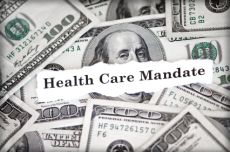
RUN RATES HERE FOR FREE SO YOU DO NOT GET A PENALTY…..
https://www.healthsherpa.com/?_agent_id=scott-thiltgen
Joe Biden, former vice president and 2020 Democratic presidential hopeful, said Friday he would bring back the individual mandate, the penalty for not having health insurance, which was a pillar of the Affordable Care Act.
“Yes, I’d bring back the individual mandate,” Biden said in an interview on CNN. The individual mandate would be popular now, “compared to what’s being offered,” he added.
Biden played an integral part in crafting the ACA, commonly known as Obamacare. However, President Donald Trump eliminated the individual mandate in 2017 by signing the Republican tax bill, effective the 2019 tax year.
The penalty for failure to have ACA-compliant health insurance is the same as it would have been under the federal individual mandate. It will cost a family $695 for each uninsured adult and $347.50 for each uninsured child or 2.5% of the household income, whichever amount is greater
The rationale behind the mandate
Health insurance, like other kinds of insurance, works by creating “risk pools,” which are groups of policyholders. In a typical risk pool, everyone pays insurance premiums, but only some will file claims. If a health insurance risk pool is large enough and has enough healthy people paying premiums, then there will be enough money available to cover the costs of those who get sick.
The rationale behind the individual mandate is that if everyone is required to have insurance—especially healthy people—the risk pools will be broad enough to lower premiums for everyone, even those with expensive medical conditions.
Who must have coverage
Unless they’re in a category of people exempt from the individual mandate, all U.S. citizens and permanent residents must have health insurance. Exempt groups include:
- People whose religion forbids them from having any health insurance
- People who are incarcerated
- Members of Native American tribes; undocumented immigrants
- Families whose income is so low that they are not required to file a tax return
- Individuals who would have to pay more than 8 percent of their income for insurance, after taking into account employer contributions or other subsidies
Which coverage counts
If you’re required to have coverage, the next consideration is what kind of coverage you have. It has to meet the federal definition of “essential care.” In general, health insurance obtained through an employer’s plan qualifies as essential care. So do Medicare, Medicaid and the Children’s Health Insurance Program. Also qualifying: Tricare insurance for military service members, retirees and their families; veterans’ medical benefits; individual health care policies that provide a certain minimum level or benefits; and any plan that existed before the law was enacted and has been “grandfathered in” by the federal government.
Tax penalties
Legislation passed in late 2017 ended the penalties beginning with the 2019 tax year.
Tax penalties for lack of coverage began accruing in 2014, and they were to phase in over a three-year period. Taxpayers are penalized for lacking coverage for themselves and for their dependents. Beginning in 2019 the penalties will no longer be assessed.
The law sets an annual penalty amount and then pro-rates that amount based on the number of months you were without coverage. For example, if your penalty amount was $300, and you were without coverage for eight months (two-thirds of the year), then your actual penalty would be $200. No penalty will be assessed for gaps in coverage lasting less than three months. Penalties for a year will be assessed and need to be paid with that year’s income tax return.
Penalty amounts specified
The penalty you pay for not having health coverage is either a dollar amount or a percentage of family income, whichever is greater. For the law’s first year, 2014, the law set the annual penalty at $95 per adult and $47.50 per child, up to a maximum of $285 per family—or 1 percent of family income, whichever is greater. For 2015, the penalty was set at $325 per adult and $162.50 per child, up to a maximum of $975 per family—or 2 percent of family income, whichever is greater. For 2016 and beyond, the law set the penalty at $695 per adult and $347.50 per child, up to a maximum of $2,085 for a family—or 2.5 percent of income, whichever is greater. Penalties are to rise with inflation.
Ultimately, Republican lawmakers passed the Tax Cuts and Jobs Act and President Trump signed it into law in December 2017. Although the tax bill left the rest of the ACA intact, it repealed the individual mandate penalty, as of 2019 (other provisions of the tax bill took effect in 2018, but the individual mandate repeal was delayed by a year).
[Although Congress did not repeal anything other than the mandate penalty (and later, some of the ACA’s taxes), a lawsuit was soon filed by a group of GOP-led states, arguing that without the penalty, the mandate itself was unconstitutional. They also argued that the mandate was not severable from the rest of the ACA, and so the entire ACA should be declared unconstitutional. A federal judge agreed with them in late 2018. An appeals court panel agreed in late 2019 that the individual mandate is not constitutional, but sent the case back to the lower court for them to decide which provisions of the ACA should be overturned.2 The case is likely to eventually make its way to the Supreme Court, and nothing about the ACA will change until that happens.

